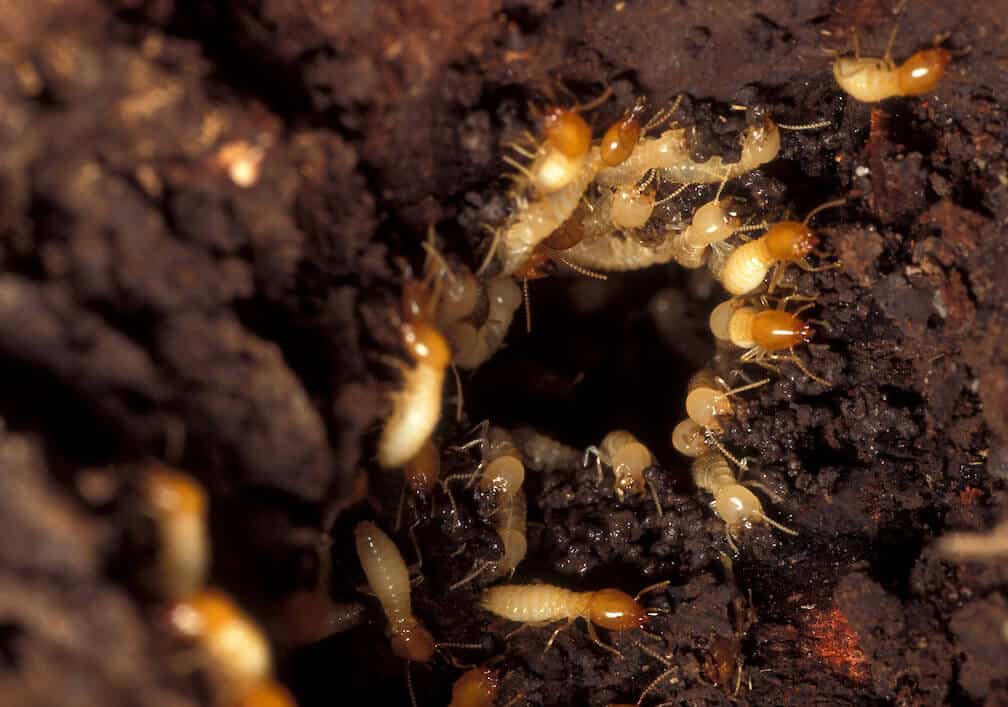Subterranean termites can strike without warning and damage a home for years without detection. These wood-eating pests cost U.S. property owners over $5 billion every single year. So, it is important to recognize the signs of a termite infestation. Sadly, property damage is often the last sign termites give.
Signs of Termites:
- Mud tunnels on the outside structures of the house, including brickwork, walls, concrete slabs and other dense structural materials. Termites build these mud tunnels to travel through when it’s not easy for them to burrow through an object while looking for food and water.
- The presence of termite swarmers inside the home. These termites are the ones that reproduce and will often fly around in large swarms looking for mates. If you see these swarmers inside a building, that’s a clue that these pests have infiltrated the structure. Seeing their shed wings along window sills is also another sign of the presence of termites.
- Wood damage is an obvious sign of the presence of termites. It can often look like water damage, or darkening of the wood, but sometimes termite bore holes are also present. If you hit the wood with a hammer or hard object and you hear a dull, thudding sound, you should have this examined for possible termite infestation.
- Tiny holes with small piles of sawdust around them are also signs of termite damage. Often these holes are no larger than a pencil lead but they can lead to a world of damage inside the wood.
- The damage is often described as a maze of tunnels. If you're looking at wood that should be solid, and it is porous and filled with troughs and channels, it has been eaten by termites.
Places You See Termite Damage:
Damaged Siding
- If you have wood siding, you may see chewed areas down near the soil, especially if your exterior walls touch the soil. This damage will look like the wood has been nibbled on. You may also see some holes and eaten areas randomly appearing on the outside surface of the wall, depending on how extensive the interior damage is.
- Damaged siding will sometimes appear if there has been a woodpile stack up against the wall. Subterranean termites prefer to avoid the drying effects of the sun and wind. It is only when they have appropriate protection that they will damage wood in a way that you will be able to see it.
- There are also many factors that will attract termites to the soil next to a home. Any ground cover that is made of wood or organic material, such as mulch, sticks, and dead leaves, will make the perfect environment for termites. It is even more ideal if those areas are damp or shaded.
Damaged Studs
- If you have a shed or outbuilding, you may be able to detect termite damage. These insects will create long channels inside the wood and make these strong timbers, brittle enough to splinter with your foot.
- Damaged studs can also be detected by tapping on them with your knuckles, or with a hammer. If they sound hollow, there could be tunneling inside.
Damaged Garage Door Frames
- When holes appear on the bottom of door frames, it could be termite damage. Chew areas will most likely be where the door frame touches the dirt, cement, or brick. Take a hammer to tap the wood and listen to see if it sounds hollow.
Damaged Walls
- You aren't likely to see termite damage in walls unless you are doing renovations. However, if termites have been damaging a wall for a long period of time, you might notice that the wall is starting to bulge out, or that the doors and windows in the wall are no longer opening or closing smoothly. As the structure weakens, the supports can bend and put pressure on doors and windows.
- If you tear into the wall, termite damage will be unmistakable. The channels they eat through studs will be evident, and the wood will look tattered.
Crawl Spaces
- If you have termite damage in the crawl spaces under your home, they may be accompanied by numerous mud tubes. Subterranean termites build mud tubes from the soil up into the wood of a home, to create moist tunnels that protect them.
Water Damage
- While termite damage is usually undetectable, an infestation may reveal itself in the form of damage that looks like it was created by water. Sometimes the surface of walls, floors, and ceilings will look swollen or bumpy.
Floor and Ceiling Damage
- When termites eat away at floors they may begin to have a dip in them or warp down, because of the weakened timbers inside. If ceilings have been damaged, they may sag, but neither of these is always the case.
Whenever you find wood damage, it is vital to have a certified termite inspector look at it. These insects can do extensive damage to a house, and it is never a good idea to let them go untreated.
If you live in our service area, Rottler Pest Solutions can help. Reach out to us right here through our website and we'll send someone over to assist you.


